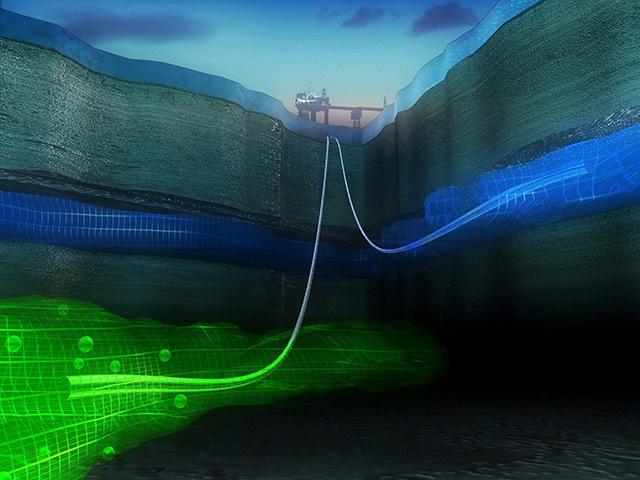Humankind will need to harness carbon capture and storage technologies to help keep global warming to 2 degrees C or less; new research shows that there’s plenty of room to store captured CO2 — in offshore geologic rock formations

Credit: Illustration: Equinor
Carbon capture and storage (CCS) will play a vital role in helping the world cut its carbon dioxide emissions, the Intergovernmental Panel on Climate Change (IPCC) says.
Yet less than two dozen CCS projects have been initiated globally, partly because of costs, but also because of uncertainty about the viability of the technology.
As policymakers wrapped up their meetings in Madrid last week to discuss the next steps to curb global warming, a new study demonstrates that there’s more than enough suitable storage for captured carbon dioxide on the world’s continental shelves.
The study, published in Nature Scientific Reports, also shows that it’s fully possible to develop enough CO2 injection wells over a relatively short period to meet the IPCC goals of using CCS to provide 13 per cent of worldwide emissions cuts by 2050.
“The great thing about this study is that we have inverted the decarbonization challenge by working out how many wells are needed to achieve emissions cuts under the 2-degree (Celsius) scenario,” said lead author Philip Ringrose, an adjunct professor at the Norwegian University of Science and Technology (NTNU) and a geoscientist at the Equinor Research Centre in Trondheim.
“It turns out to be only a fraction of the historical petroleum industry — or around 12,000 wells globally. Shared among 5-7 continental CCS hubs — that is only about 2,000 wells per region. Very doable! But we need to get cracking as soon as possible.”
Pressure, not volume, the deciding factor
Ringrose and his co-author, Tip Meckel from the University of Texas Bureau of Economic Geology, first looked at continental shelves worldwide to get a sense of how much capacity there would be to store carbon dioxide.
Previous studies of how much storage would be available offshore have mainly looked at estimated volumes in different rock formations on the continental shelf. The authors argue, however, that the ability of the rock formation to handle pressure is more important in figuring out where CO2 can be safely stored.
That’s because injecting CO2 into a rock formation will increase the pressure in the formation. If the pressures exceed what the formation can safely handle, it could develop cracks that would require early closure of projects.
A classification system and history
Given that assumption, the researchers developed a way to classify different storage formations according to their ability to store CO2. Under this approach, Class A formations are those without significant pressure limits, and thus the easiest to use, while Class B formations are those where CO2 can be injected into the system up to a certain limit, and Class C formations are those where pressures will have to be actively managed to allow the CO2 to be injected.
“We argue that this transition from early use of CO2 injection into aquifers without significant pressure limits (Class A), through to CO2 storage in pressure-limited aquifers (Class B) and eventually to pressure management at the basin scale (Class C), represents a global technology development strategy for storage which is analogous to the historic oil and gas production strategy,” the researchers wrote.
Essentially, the authors say, as experience with injecting CO2 into offshore formations grows, the ability to use the Class B and C areas will improve, much as geologists and petroleum engineers have gotten better over the decades at extracting hydrocarbons from more and more challenging offshore formations.
Can we drill fast enough?
It’s one thing to have enough space to store CO2 — you also have to inject it into the storage formations fast enough to meet the IPCC estimates of 6 to 7 gigatons of carbon dioxide a year by 2050.
By comparison, “Four existing large-scale projects inject 4 million tonnes CO2 per year. If all 19 large-scale CCS facilities in operation together with a further 4 under construction are considered, they will have an installed capture capacity of 36 million tonnes per year,” the researchers wrote. This is clearly not enough, since a gigatonne is 1,000 million tonnes.
Nevertheless, the history of the oil and gas industry suggests that ramping up the technology and infrastructure required to reach the IPCC target by 2050 is very doable, the researchers wrote. Assuming an average injection rate per well, they calculated that more than 10000 CO2 wells would need to be operating worldwide by 2050.
While this may seem like an enormous number, it’s equivalent to what has been developed in the Gulf of Mexico over the last 70 years, or five times what has been developed by Norwegians in the North Sea.
“Using this analysis, it is clear that the required well rate for realizing global CCS in the 2020-2050 timeframe is a manageable fraction of the historical well rate deployed from historic petroleum exploitation activities,” the researchers wrote.
“With this paper, we provide an actionable, detailed pathway for CCS to meet the goals,” Ringrose’s co-author Meckel said. “This is a really big hammer that we can deploy right now to put a dent in our emissions profile.”
###
The study was funded by NTNU and the University of Texas Bureau of Economic Geology’s Gulf Coast Carbon Center, with some support from Equinor.
Reference: Ringrose, P.S., Meckel, T.A. Maturing global CO2 storage resources on offshore continental margins to achieve 2DS emissions reductions. Sci Rep 9, 17944 (2019) doi:10.1038/s41598-019-54363-z
Media Contact
Philip Ringrose
[email protected]
Original Source
https:/
Related Journal Article
http://dx.




